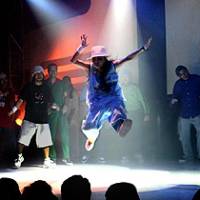Few things were as emblematic of 1980s America as "breaking," the inner-city dance style whose head-spinning and somersaulting acrobatics became a world sensation.
Break-dancing -- or "b-boying," as its creators call it -- along with rap music, graffiti, "beat-boxing" (creating beats and music with the mouth) and DJ'ing (mixing tunes and beats on turntables) are the "five elements" of hip-hop culture. Born in the United States, the movement has, in the last two decades, permeated the youth scene from New York to Nagoya, Stockholm to Soweto.
So it was with a tinge of nostalgia in their eyes that four Americans who helped lay the groundwork for hip-hop recently visited Tokyo. Here to promote the DVD release of "Beat Street," "Breakin' " and "Breakin' 2: Electric Boogaloo" -- three 1984 films that were seminal to the original propagation of the b-boy gospel. Their trip was also a chance for them to review how their work struck such a chord on this side of the Pacific, too, and to see to what an amazing extent one culture can absorb elements of another.
Still groggy on that Saturday afternoon from their long flight, the visiting dignitaries -- spinmeister The Original DJ Jazzy Jay (one of the first DJs to "scratch" with a turntable needle) and dancers Icey Ice, Popin' Taco and Zulu Gremlin -- sauntered into the Duo Music Exchange nightclub in Shibuya to join the few dozen professional Japanese break dancers. The event had been organized by Twentieth Century Fox Home Entertainment Japan, who are releasing the DVDs to tap into Japan's latest hip-hop dance boom.
Kicking off the action was the 35-year-old Gremlin (born Steven Roybal), whose wiry body seems to be perpetually in motion ("I don't sleep; I rest."), and who -- as a hard-working father of two who barely touches alcohol -- is clean-living proof that hip-hop is not all about violence and drug-driven excess. Dressed in a baseball jersey with a giant "B" on the front, he launched like a man possessed into a high-octane rehearsal of the evening's performance that reenacts an '80s-style neighborhood block party in New York.
But, uh-huh, the party got off to a bumpy start when the Japanese dancers proved oddly resistant to direction.
It wasn't that anybody questioned Gremlin's clout. Among his many hip-hop credentials is one-time membership in the Bronx b-boy collective Rock Steady Crew, source of some of the other greatest b-boys of all time, including the inimitable Richard "Crazy Legs" Colon and Steve "Mr. Wiggles" Clemente.
Feline indifference
The point is, the local performers were accomplished hip-hop dancers in their own right. One veteran b-girl who goes by the name Yoshie, for example, has toured as a dancer for pop-star Namie Amuro and could hold her own in any U.S. hip-hop jam. According to insiders present, the cast's feline indifference suggested they weren't keen to take directions from an American, regardless of his street creds. This was their 'hood!
Gremlin bravely forged on anyway. "Exaggerate! Exaggerate!" he implored through his interpreter. "You want to make it look believable!" Then, as if beseeching the heavens: "I wish I could speak Japanese right now."
Off stage doing yoga stretches in his olive-green Puma training wear, Icey Ice (Bronx native Corey Montano) seemed more enchanted by the slight cultural impasse than put off. After all, this was the first time the 36-year-old had visited the land of cherry blossoms and sake. "There I was, a kid from the Bronx," Ice, who now has a young daughter and anthropologist wife, said cheerily. "I always wanted to come to Japan, and here I am today!"
All in all, Ice had mostly good things to say about the growth of hip-hop he's witnessed as a professional judge at contests across the America and Europe. European b-boys, he said, have mastered "power moves" -- absurdly difficult techniques with names like "headmill," "nutcracker" and "atomic freeze." Japanese, meanwhile, pay more attention to rhythm and what he called "the soulful connection of the dance."
But what's lacking in both Europe and Japan, he said, is the creative impulse without which no b-boy can hope to leave a legacy.
"I can see one guy doing what we call an 'air flare' " -- imagine Mikhail Baryshnikov executing leaping kicks and cartwheels . . . simultaneously -- "and I'll see 30 other individuals do the same move in a competition. Not one of those b-boys did anything to try to twist it and make it their own."
For his part though, the 43-year-old Jazzy Jay (who prefers to keep his "government name" under raps) explained over a beer in the dressing room that he felt Japanese dancers cared a bit too much about detail. What did it matter whether some dance move was "East Coast" or "West Coast" if Japanese don't deliver something new from between their own coasts?
"I want to see somebody who's going to come right out and say, 'Hey listen, forget the labels, forget the titles, I just wanna incorporate everything that I've learned and put it into one bucket and let me just draw from that,' " he intoned from his seat. But with their considerable skills, the Japanese may very well pull it off, he said. "Why not?"
By now, the club was filling up as some 700 hip-hop fans -- clad in de rigueur baggy shorts, jerseys, baseball caps and sneakers -- filed in and politely took their seats as a screening of "Beat Street" began.
If the American luminaries were to teach a course on hip-hop, they would assign this film as homework. Throughout the movie we see the characters (among them a youthful Icey Ice and Jazzy Jay) driven by a relentless desire to innovate in dance, music and graffiti art -- and perhaps nowhere is this urge dramatized better than in a club battle in which two b-boy crews vie to out-dance each other. The result: fireworks.
After the movie screening finished, Jazzy Jay revved up the turntables and it was time for b-boys and b-girls to take to the stage.
The audience broke into rapt applause during a routine by Gremlin that climaxed with a spin on one palm and clockwork stop in a floor pose that said: "Yeah, match this."
Not to be outdone, Ice then came out and wowed the crowd by windmilling his legs in the air from a handstand position, his biceps looking set to burst the sleeves of his T-shirt. You could almost feel the breeze in the audience.
Then came 41-year-old Popin' Taco (Bruno Falcon), a star of the "Breakin' " movies who is said to have taught Michael Jackson how to moonwalk, but who here lived up to his name by gettin' down with some "popping" on the floor -- a routine that looked something like mime maestro Marcel Marceau with a mouse running up and down his spine.
Crackling with electricity
No question about it, the Americans were breathtaking. And yet the air crackled with electricity, too, when Japanese troupe Coin Lockers, of Chiba Prefecture fame, showed off their robotic "locking" skills, or when fellow countrymen Flash and Roy 9 revealed how well they could stand the test of the b-boy battle that followed.
Was it original? Was it innovative? East Coast or West Coast?
Nobody could care less -- least of all DJ Jazzy Jay, who was in another world, spinning his vinyl with better things to think about.
And wherever you looked, everybody was smiling. Relaxed. Nodding their heads to the thumping bass, making the music and dance their own.
Come to think of it, it was a lot like one of those '80s block parties, back in the day.





















With your current subscription plan you can comment on stories. However, before writing your first comment, please create a display name in the Profile section of your subscriber account page.